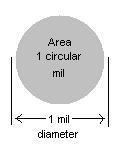 | ||
A circular mil is a unit of area, equal to the area of a circle with a diameter of one mil (one thousandth of an inch). It corresponds to 5.067×10−4 mm². It is a unit intended for referring to the area of a wire with a circular cross section. As the area in circular mils can be calculated without reference to π, the unit makes conversion between cross section and diameter of a wire considerably easier.
Contents
- Equivalence to other units of area
- AWG circular mil formula
- Standard sizes
- Circular inch
- IEEE std 525
- References
The area in circular mils, A, of a circle with a diameter of d mils, is given by the formula:
In Canada and the United States the National Electrical Code (NEC) uses the circular mil to define wire sizes larger than 0000 AWG. In many NEC publications and uses, large wires may be expressed in thousands of circular mils, which is abbreviated in two different ways: Kcmil or MCM. For example, one common wire size used in the NEC has a cross-section of 250,000 circular mils, written as 250 kcmil or 250 MCM, which is the first size larger than 0000 AWG used within the NEC.
Equivalence to other units of area
As a unit of area, the circular mil can be converted to other units such as square inches. A 0000 AWG solid wire is defined to have a diameter of exactly 0.46 inch.
Formula 1: Circular Mil
Note: 1 inch = 1000 milsFormula 2: Square Mil
Formula 3: Square Inch
Formula 4: Solving for Circular Mil
Formula 5: Solving for Square Mil
1 square milTherefore, the following conversions apply:
To obtain square mils ⇒ (# of circular mils) × π ÷ 4To obtain square inches ⇒ (# of circular mils) × π ÷ 4,000,000To obtain circular mils ⇒ (# of square mils) × 4 ÷ πTo obtain circular mils ⇒ (# of square inches) × 4,000,000 ÷ π1 circular mil is approximately equal to:
1000 circular mils = 1 MCM or 1 kcmil, and is (approximately) equal to:
Therefore, for practical purposes such as wire choice, 2 kcmil ≈ 1 mm² is a reasonable rule of thumb for many applications.
1_circular_mil = π × (1e−3 / 2 × 25.4)2 = 506.7×10−6mm2
1_MCM = 1000 circular_mil = 506.7×10−3mm2
When large diameter wire sizes such as the widely used 250 kcmil and 350 kcmil wires are specified in kcmil, the wire's diameter can be easily determined with the following formula:
Formula 6: diameter
Note: We first convert from kcmil to circular milThus, this wire would have a diameter of a half inch or 12.7 mm.
AWG circular mil formula
The formula to calculate the circular mil for any given AWG (American Wire Gauge) size is as follows. An represents the circular mil area for the AWG size n.
Sizes with multiple zeros are successively larger than the number 0 gauge size and can be denoted using "number of zeros/0"; for example 4/0 for the number 0000 gauge. For an m/0 AWG wire size, use
n = −(m − 1) = 1 − m in the above formula.For example, the number 0000 gauge or 4/0 gauge, would use n = −3; and the calculated result would be 211,600 circular mils.
Standard sizes
Standard sizes are from 250 to 400 in increments of 50 kcmil, 400 to 1000 in increments of 100 kcmil, and from 1000 to 2000 in increments of 250 kcmil.
The diameter in the table below is that of a solid rod with the given conductor area in circular mils. Stranded wire is around 5% larger in diameter to allow for gaps between the strands, depending on the number and size of strands.
Note: For smaller wires, consult the Table of AWG wire sizes article.
Circular inch
Cardarelli has asserted that the "circular inch" (cin) was used as a unit for the measurement of wire sizes, with a conversion of 1 circular inch = 1 million circular mil. The Oxford English Dictionary has an entry for "circular mil", but not for "circular inch".
IEEE std 525
Anexo C, C1.2.
1cmil = 5,067x10^−4 mm2
